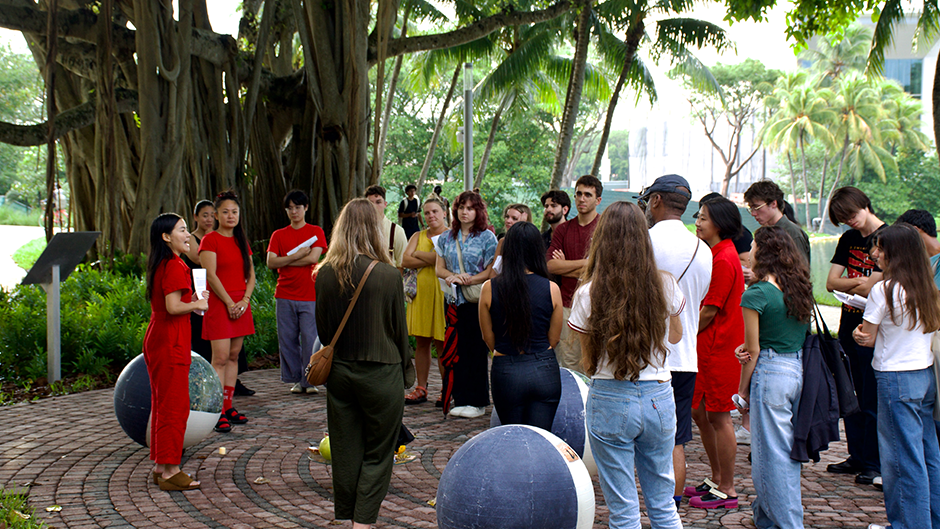In celebration of the mid-autumn full moon, University of Miami School of Architecture Social Justice Prize winner, Professor Lily Chishan Wong and Xiaoxi Chen, hosted Moonrise on Monday, September 16, 2024. Set against the tranquil backdrop of Lake Osceola and held under the sprawling Banyan tree in the school’s courtyard, the event brought together students, faculty, and staff from the University of Miami and Florida International University. Combining academic inquiry and cultural celebration, Moonrise explored Asian diasporic worldviews, spatial practices, and agricultural traditions through a series of talks, an installation, and a drawing workshop.
The Mid-Autumn Festival, a time-honored tradition celebrated across many Asian communities, served as the backdrop for these conversations. The festival's symbolism—fullness, reflection, and togetherness—paralleled the themes of interconnectedness and shared space that Moonrise sought to evoke. South Florida’s own agricultural landscape is deeply intertwined with Asian diasporic histories, forming a crucial node in the supply chain for produce that reaches Chinatowns and Asian markets throughout the northeastern United States. The engineered ecosystems of the Everglades Agricultural Area, supported by the intricate water systems of Lake Okeechobee and the Kissimmee River, form the backbone of this agricultural output. Scattered among these larger operations are independent farms and home gardens in Homestead and Redland that specialize in plant species native to Asia, providing essential ingredients for maintaining culinary and cultural traditions.
Within this rich tapestry, Moonrise highlighted the ways in which agricultural spaces in South Florida are not just sites of production but also of social and cultural exchange, linking local practices to global diasporic communities. The event was co-organized by Professor Lily Wong and Xiaoxi Chen, Assistant Director of the M.S. of Advanced Architectural Design at the Graduate School of Architecture, Planning, and Preservation at Columbia University, whose work delves into the entanglements of spatial practices, colonial histories, and ecological systems within Asian diasporic communities. Chen’s research focuses on the cultural dynamics of Chinatowns and the potential for creating abolitionist futures for these spaces, while Wong’s examines how the agricultural histories of South Florida, particularly in Homestead and Redland, have shaped the region’s landscape and demographics.
Throughout the summer, Wong and Chen visited community centers, independent farms, and home gardens to understand the spatial and social configurations of food systems that support Asian cuisines. This fieldwork informed the event’s design, which aimed to move beyond conventional research presentations. Supported by the University of Miami’s Social Justice Prize, the event provided a platform for Wong and Chen to share their findings and collaborate with emerging scholars Stephanie Lee, Ricky Li, and Saung Yatu, whose work on related themes contributed to a broader dialogue on spatial practices, legalities, and environmental management.
Set at Lake Osceola under the banyan tree, the installation featured a series of half-black exercise balls printed with images, serving as heuristic devices that anchored the discussions. Participants were encouraged to engage with the installation, transforming it into a collaborative canvas during the subsequent drawing workshop. Glass lazy susans, laden with mooncakes and tropical fruits, adorned the space, inviting attendees to reflect on the sensory experiences tied to food and memory. Several students contributed items personal to their own mid-autumn festival celebrations, adding to the shared sense of community.
The talks that followed unpacked different facets of the Asian American experience in relation to agricultural practices in South Florida. Wong traced the emergence of Asian-run home gardens and farming communities in Homestead and Redland, emphasizing how these spaces function as “outdoor greenhouses” for growing a variety of vegetables and fruits that supply diasporic food networks along the East Coast. Stephanie Lee highlighted the history of land grabs affecting Asian American agricultural settlements, examining policies from the Homestead Act and the Chinese Exclusion Act to contemporary Sinophobic legislation like Florida’s SB 264, which restricts land ownership by certain foreign nationals.
Ricky Li, co-leader of the Workshop for Environmental Technik, situated his curatorial project Breach, which contextualizes the archives of the U.S. Army Corps of Engineers’ work on water-related infrastructures within art institutions. He discussed how oceanic spaces have historically mediated modern enclosures and exposures, highlighting the complex relationship between architecture, environment, and policy. Chen’s presentation delved into how calendars function as spatial-political instruments in the making of Chinese societies, illustrating how the political demise of the lunisolar calendar and subsequent adoption of Gregorian and Greenwich Mean Time marked a shift in temporal realities for these communities.
The event concluded with a drawing workshop titled How to Draw A Banyan Tree. Led by Wong and Chen, participants collectively created drawings inspired by their surroundings, using the installation as both canvas and medium. This embodied exercise invited participants to sense and engage with their environment in a meditative manner, tracing and recording cosmological relations between themselves and the broader ecological landscape.
What emerged from Moonrise was a renewed understanding of how land, culture, and identity intersect in South Florida, where Asian diasporic communities continue to shape the region’s agricultural and cultural landscapes. The event provided a space for Wong and Chen to expand their research network and create a platform for future collaborations. Inspired by this initial success, they hope to iterate on the design and format of Moonrise, using it as a framework for future presentations in other cities.
As they continue to engage with the Asian communities in Homestead and Redland, Saung Yatu, a graduate M.Arch student from Myanmar, shared insights from her entrepreneurial work sourcing tropical produce in the region will serve as an invaluable perspective. The partnerships and dialogues initiated at Moonrise will lay the groundwork for a continued exploration of how Asian diasporic experiences are deeply intertwined with the land and how academic research can foster meaningful connections with these communities.

